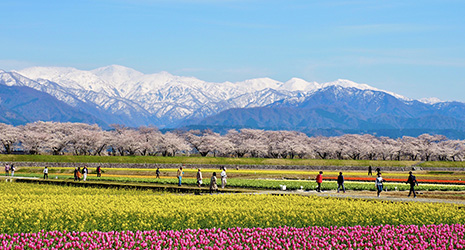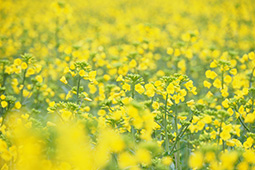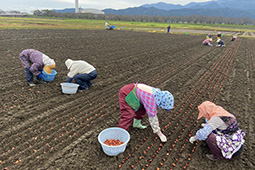April 2022
- English
- 日本語
Asahi Funakawa “Spring Quartet”

Cherry blossoms, rapeseed flowers and tulips bloom against the backdrop of the lingering snow on Mt. Asahi-dake 
Cherry trees lining the Funakawa River

Tulips 
Rapeseed flowers 
Planting tulip bulbs

When spring comes to Asahi Town in Toyama Prefecture, crowds are drawn to the cherry trees, tulips and rapeseed flowers that burst into bloom together at the foot of a mountain still covered with snow—a colorful scene known as the “Spring Quartet.”

In Asahi Town on the eastern edge of Toyama Prefecture there is a colorful spring scene in which the rows of cherry trees along a 1.2-km stretch of the Funakawa River bloom at the same time as the tulips and rapeseed flowers in nearby fields. This panorama of delicate pink cherry blossoms, red, white and yellow tulips, and brilliant yellow rapeseed flowers, with a snow-capped Mt. Asahi-dake (elevation of 2,418 meters) as the backdrop, is known as the “Spring Quartet” and attracts many people.
In fact, tulip bulbs have been cultivated in Toyama Prefecture for a little more than a century. At one point, close to 60% of all the tulip bulbs sold in Japan were cultivated in Toyama Prefecture. In recent years, however, domestic bulbs have been replaced by imported ones, and only one tulip bulb farm remains in Asahi Town, down from a high of thirty during the town’s tulip producing heyday.

That farm is Tulist Yamazaki. Its owner, Yamazaki Hisao, listened to local senior citizens who missed growing tulip varieties that bloomed at the same time as the cherry blossoms, and acquired an extremely early blooming variety from the Netherlands and tried to cultivate them. These tulips bloomed at the same time as the cherry blossoms for the first time in 2009. Since then, Yamazaki has planted rapeseed, which bloom around the same time, and has worked to cultivate those flowers with the creation of scenery in mind—as if he is painting a picture of spring fields stretching out towards the mountain.

“The rows of cherry trees along the Funakawa River were planted in 1957 when river improvements were carried out,” says Kamisawa Seiko of the Asahi Town Tourism Association. “Local people planted around 280 cherry trees, which are of the Somei-yoshino variety. Since then, local people have worked to ensure that the trees are kept well by pruning them and preventing disease and insect damage.”
Local people also help with tulip bulb cultivation. One of the most laborious parts of tulip bulb cultivation for farmers is the picking of blooming flowers* to allow nutrients to be stored within the bulb. Therefore, the Tourism Association recruits a “Tulip Flower Picking Team” to help the farmers. Each year, many parents join the team along with their children, and the picking of flowers has become an activity meant to pass down the “Spring Quartet” to the next generation while enjoying it at the same time.

* It may seem like picking the flowers is a waste, but it is a necessary task to promote bulb enlargement. The bulbs grow underground for about six weeks after the flowers are picked, and before the rainy season in June arrives, the bulbs are dug up, dried, and stored until it is time for the bulbs to be planted and take root again.

